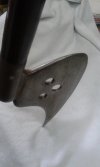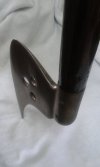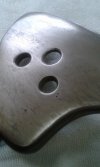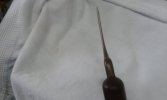- Joined
- Aug 17, 2003
- Messages
- 3,407
my axe appears to be similar to one listed at lutel.com, the czech replica makers, as a 'central european war axe 13-15c. rather vague. theirs, unlike mine, has the blade riveted to the socket and sharpened on all sides. can anyone shed any light to pin it down a bit more on area of origin and time frame, on mine? lutel must have gotten the design from somewhere, a museum or castle display?
cutting edge is quite sharp, convex. couple small nicks.lower rounded part is not sharp, neither is the back of the point, all rounded rather than flat. eye is enclosed rather than open. a silver pin is used to keep the head on. grip rings are copper, except the 'pommel' one is steel and open on the base where the strap ends were... sadly strap fell apart into powder as i unpacked it. haft has been varnished. three holes appear punched with a drift hammer and countersunk rather than drilled. no makers marks
weight is 1165 grams, or 2.56 lb. (or 41 oz.)
haft is 34.5 in. from tip of the socket to the pommel end. roughly 1 & 3/16 in. dia. at the socket, grip section 1 in. dia. in the grooves. socket 3 in. heavy steel pommel piece 2 in., edge is 8 & 5/8 in. top to bottom, roughly 4 in. across. the blade x-section tapers from the socket to the edge as a shallow triangle and is about 1/2 in. thick where it joins the socket, the join is nicely radiused.
appears to be a heavy weapon rather than a tool or parade axe.
thanks in advance for any info.
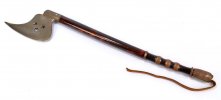
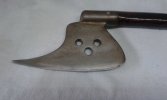
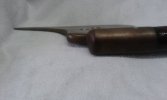
cutting edge is quite sharp, convex. couple small nicks.lower rounded part is not sharp, neither is the back of the point, all rounded rather than flat. eye is enclosed rather than open. a silver pin is used to keep the head on. grip rings are copper, except the 'pommel' one is steel and open on the base where the strap ends were... sadly strap fell apart into powder as i unpacked it. haft has been varnished. three holes appear punched with a drift hammer and countersunk rather than drilled. no makers marks
weight is 1165 grams, or 2.56 lb. (or 41 oz.)
haft is 34.5 in. from tip of the socket to the pommel end. roughly 1 & 3/16 in. dia. at the socket, grip section 1 in. dia. in the grooves. socket 3 in. heavy steel pommel piece 2 in., edge is 8 & 5/8 in. top to bottom, roughly 4 in. across. the blade x-section tapers from the socket to the edge as a shallow triangle and is about 1/2 in. thick where it joins the socket, the join is nicely radiused.
appears to be a heavy weapon rather than a tool or parade axe.
thanks in advance for any info.




